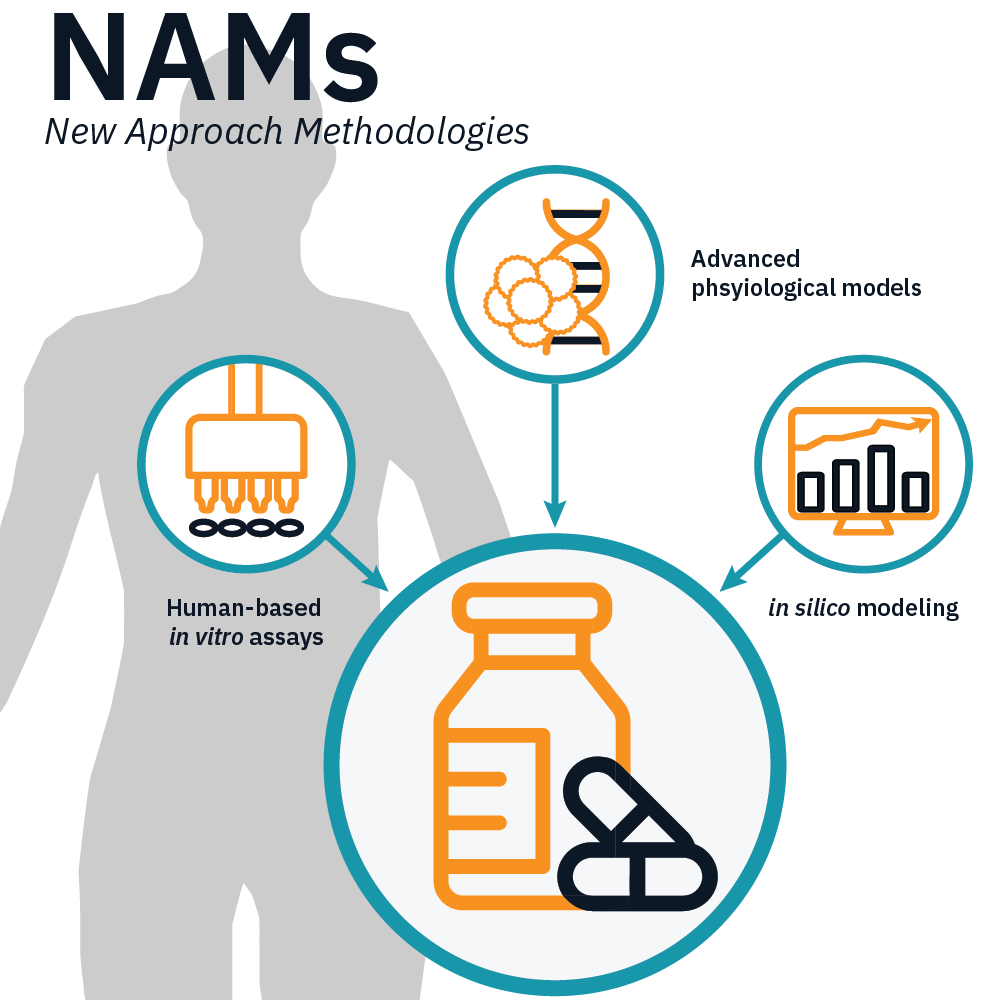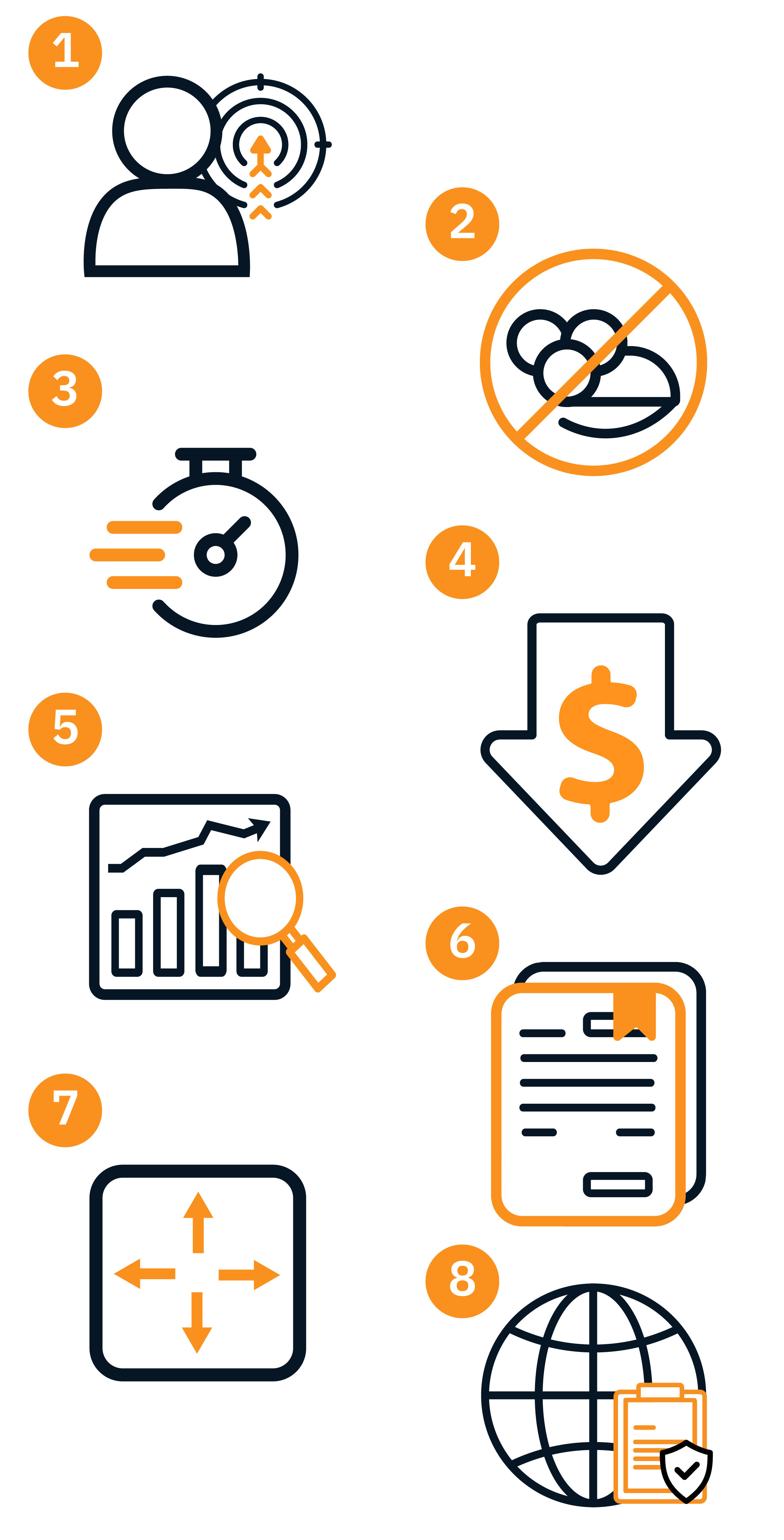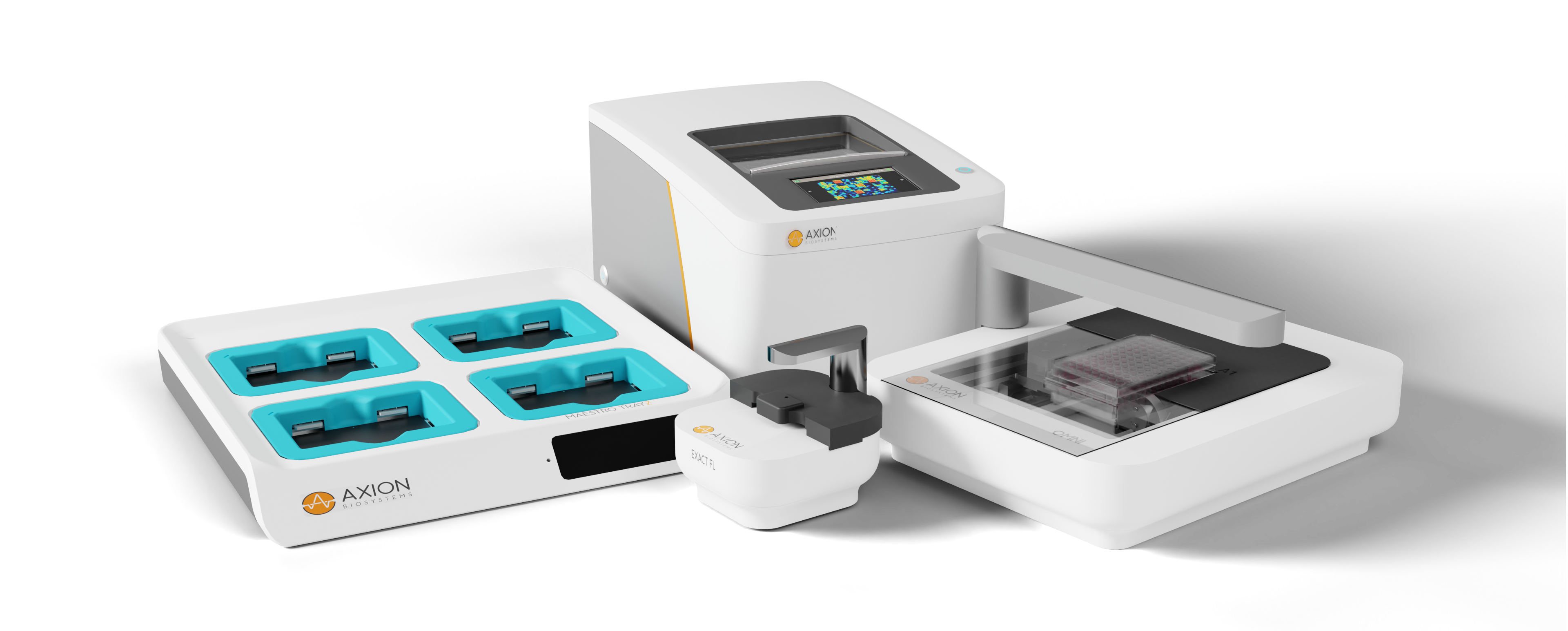The FDA's 2025 guidelines on New Approach Methodologies (NAMs) mark a significant shift in the regulatory landscape, aiming to reduce reliance on animal testing and promote the adoption of innovative, human-relevant testing methods. Additional backing for this initiative was also announced by the NIH.
New Approach Methodologies, or NAMs, are non-animal testing methods used in biomedical research and safety testing. First introduced around 2017, NAMs are increasingly being adopted by scientists and have recently been cemented by the FDA in its 2025 “Roadmap to Reducing Animal Testing in Preclinical Safety Studies” initiative, which aims to reduce animal testing over a 3-year period and ultimately make animal studies the exception rather than the rule in preclinical safety testing by year 5. Under the current roadmap, the first type of therapeutic subject to the NAMs initiative will be monoclonal antibodies, followed by “other biological molecules and eventually new chemical entities and medical countermeasures.”
Topics:
What are New Approach Methodologies? (NAMs)
New Approach Methodologies (NAMs) aim to replace, reduce, or refine animal testing by using:
- 1. human-relevant in vitro assays
- 2. advanced physiological models such as three-dimensional organoids and microphysiological systems like organs-on-chips
- 3. in silico tools and computational modeling
According to the 2025 FDA roadmap, human-relevant in vitro systems, used in combination with other innovative approaches—such as omics-based analyses, in silico modeling powered by AI and machine learning, and bioprinting or scaffold-based tissue engineering— can be used to "collectively evaluate immunogenicity, toxicity, and pharmacodynamics in humans and provide an opportunity to improve the predictive relevance of preclinical drug testing while reducing or replacing animal use.”

Did you know?
Maestro MEA cardiotox and seizurogenic assays have been an industry standard of in vitro MEA tox testing for years, having undergone numerous cross-site validation studies.

9 out of the top 10 pharmaceutical companies
have a Maestro MEA in their tox and safety programs
What are the advantages of New Approach Methodologies (NAMs)?
Animal testing is costly and time-consuming, in addition to raising ethical considerations. Furthermore, animal studies are often poorly predictive of potential drug-induced adverse events in humans. In fact, over 90% of drugs that pass preclinical animal testing fail in human clinical trials – with up to 60% due to lack of efficacy and about 30% due to unmanageable toxicities (primarily cardiovascular, hepatic, and central nervous system).
New Approach Methodologies (NAMs) offer many advantages compared to traditional animal testing, including faster drug development and lower costs. Additionally, by using human-relevant models, scientists can predict safety issues earlier in the drug development process, or “fail faster,” and avoid costly late-stage failures and market withdrawals.
- 1. Human-relevant models – New Approach Methodologies typically use human cells or tissues, which improves translational accuracy to human outcomes.
- 2. Reduced reliance on animal testing – The NAMs roadmap aligns with ethical standards and global efforts to replace, reduce, and refine animal use (3Rs).
- 3. Faster results – High-throughput capabilities and automation can accelerate data collection and help guide decision-making.
- 4. Cost-effective – NAMs can lower costs by reducing animal care and housing needs, shortening study durations, and accelerating regulatory processes.
- 5. Mechanistic insights – Some NAMs allow for real-time, functional readouts of cellular activity to uncover the mechanisms of disease or toxicity.
- 6. More reproducible data – Standardized in vitro systems can help minimize variability common in animal models and improve predictive accuracy.
- 7. Scalable and flexible – Unlike animal models, NAMs can be easily adapted to assess different disease areas, drug candidates, and testing protocols.
- 8. Align with global regulatory trends – NAMs are increasingly accepted by regulators worldwide seeking alternatives to animal testing.

What are the key impacts of the new FDA roadmap on regulatory submissions?
Recent changes to FDA guidelines underscore the agency's commitment to modernizing drug evaluation processes, enhancing patient safety, and reducing animal use in research. By embracing NAMs, sponsors can align with regulatory trends and contribute to more ethical and efficient drug development pathways.
>> Incorporation of NAMs in Submissions: The FDA is encouraging sponsors to include NAMs data—such as results from organ-on-a-chip systems, advanced in vitro assays, and AI-based models—in their Investigational New Drug (IND) applications and other regulatory submissions. This move supports the transition towards more predictive and ethical testing methods.
>>Streamlined Review Processes: Submissions that effectively use validated NAMs may benefit from expedited review timelines. The FDA has indicated that strong non-animal safety data could lead to more efficient evaluations, potentially accelerating the drug development process.
>> Pilot Programs for Biologics: The FDA has initiated pilot programs focusing on monoclonal antibodies and other biologics, allowing select developers to use NAMs-based testing strategies. Insights from these programs will inform broader policy changes and future guidance updates.
>> Global Data Integration: The agency plans to consider real-world safety data from other countries with comparable regulatory standards, potentially reducing the need for redundant animal testing and facilitating international collaboration.
Strategic Considerations for Sponsors
>> Early Engagement with the FDA: Sponsors are encouraged to engage with the FDA early in the development process to discuss the integration of NAMs into their testing strategies and to ensure alignment with regulatory expectations.
>> Validation of NAMs: Demonstrating the scientific validity and reliability of NAMs is crucial. Sponsors should provide robust data to support the use of these methodologies in their specific context.
Axion iPSC Model Standards (AIMS)
AIMS seeks to leverage the expertise of key opinion leaders in the field and set minimum acceptance criteria for stem-derived model activity when used in Maestro MEA assays.

In vitro assay tools for New Approach Methodologies
As the demand for human-relevant, animal-free testing solutions grows, Axion BioSystems’ suite of live-cell analysis tools including next-generation Maestro multielectrode array (MEA) systems, impedance-based Maestro Z analyzers, and AI-powered Omni imagers are essential to support New Approach Methodologies in drug discovery and preclinical safety.

>> Maestro multielectrode array (MEA) systems measure the real-time electrical activity of neurons and cardiomyocytes without labels or dyes, perfect for assessing functional responses to drugs in cardiotoxicity and seizurogenic assays. Featuring the best throughput and a proven track record, Maestro MEA is ideal for evaluating 2D cell cultures or 3D neural and cardiac organoids, spheroids, or assembloids, as well as microphysiological or organ-on-chip models.
>> Maestro Z impedance-based analyzers track viability, proliferation, and barrier integrity, offering a noninvasive way to study cell health, cytotoxicity, immune responses, and more. The Maestro Z platform is widely used in the drug development process of monoclonal antibodies, bispecific antibodies, CAR T-cell therapies, and other types of anticancer therapies. Its TEER capabilities can be used for evaluating gut, lung, and blood-brain barrier models.
>> Omni & Lux live-cell imaging enables researchers to automatically visualize and quantify dynamic biological processes as they occur in vitro, providing rich, kinetic data while preserving the natural cell environment. The flexible Omni can be used to monitor and assay 2D and 3D cultures in flasks, well plates, and microfluidic devices.
>> Exact cell counters offer fast, accurate cell counting of cells and organoids. The first step to an accurate in vitro cell assay is an accurate cell count.
Together, these label-free, noninvasive systems provide reliable, reproducible, human-relevant data that support regulatory goals and help reduce reliance on animal models—making them powerful tools for advancing the future of biomedical research. In fact, neural and cardiac Maestro MEA assays are at the forefront of safety assessment in therapeutic development at 9 of the 10 top pharmaceutical companies and offered as a service at over 20 leading CROs.
Human-based in vitro iPSC cardiotoxicity assays
The inability to predict a drug’s cardiovascular liability prior to clinical trials or launch has resulted in numerous costly late stage drug development failures and market withdrawals, but New Approach Methodologies like human stem cell-derived cardiomyocyte MEA assays on Maestro can reveal real-time functional changes in cardiac activity in vitro and provide early insights into potential cardiac risks during preclinical testing. In a head-to-head study Maestro MEA was shown to be the most reliable, most predictive, and least variable platform for human in vitro cardiotoxicity assays.

Don't miss a beat with LEAP: An advanced arrhythmia assay (CiPA)
Listen in to hear Axion BioSystems’ Dr. Daniel Millard discuss advances in arrhythmia risk detection to support next-generation CM-MEA assays.
Predicting seizures with in vitro iPSC neurotoxicity assays
Neurotoxicity is a leading cause of pharmaceutical compound attrition. Drug-induced seizures, which are the result of excessive and synchronous firing of cortical neurons in the brain, can deprive the brain of oxygen resulting in brain injury and an increased incidence of mortality. Microelectrode array assays on Maestro have emerged as a promising New Approach Methodology to predict seizure risk by measuring drug-induced changes to the spontaneous firing activity of neural networks in vitro. In this webinar, Dr. Benjamin Bader of NeuroProof discusses how artificial intelligence-based machine-learning can be applied to these neural MEA datasets to improve the prediction of seizure risk.

Seizure Prediction using AI
In this webinar, Dr. Benjamin Bader of NeuroProof discusses how artificial intelligence-based machine-learning can be applied to these neural MEA datasets to improve the prediction of seizure risk.
In Vitro Human-Derived Systems: Organoids and Microphysiological Systems
Organoids, are complex, self-organizing, three-dimensional in vitro stem cell-derived models. They offer a more human-relevant, ethical, and advanced alternative to traditional 2D and animal models. Organoids have been developed for a wide range of organs, including brain, heart, liver, intestine, lung, kidney, and more—allowing broad use in biomedical research. Axion Biosystems’ innovative live-cell analysis tools are widely used in organoid research, particularly in the fields of neuroscience, cardiovascular research, oncology, and stem cell biology.
Organ-on-a-chip is a New Approach Methodology that combines cells and tissues grown inside microfluidic chips with the aim of recapitulating physiological processes of human organs. The applications of organ-on-a-chip range from disease modeling and drug testing to personalized medicine and the development of cell and gene therapies. Microphysiological systems have been shown to be as predictive, or more predictive, of effects on humans compared to animal models There are a diverse array of organ-on-a-chip devices available including brain-on-a-chip, heart-on-a-chip, liver-on-a-chip, and others. Axion’s innovative platforms can noninvasively monitor cells in microfluidic systems, allowing the study of complex physiological processes without the use of animals.
Standardizing organoid production and analysis
Mike Clements, PhD discusses how Omni live-cell imaging and Maestro MEA come together to create a complete workflow for monitoring the production and function of your organoids.
Frequently asked questions about NAMs
Why is the FDA starting the NAMs initiative with monoclonal antibodies?
The FDA is starting the NAMs initiative with monoclonal antibody (mAb) drugs because they are well-characterized, low-risk, and already supported by reliable non-animal tests. mAbs have predictable behavior, low toxicity, and often don’t benefit from traditional animal studies, making them an ideal starting point. This approach allows the FDA to safely reduce animal use while building confidence and setting the stage for broader application of NAMs across other drug types.
Why are NAMs often preferred over animal testing methods?
NAMs (New Approach Methodologies) are often superior to animal models for toxicity testing because they use human cells and tissues, offering more accurate predictions of human responses. These methods are faster, more cost-effective, and scalable, enabling high-throughput screening of compounds. NAMs also provide deeper mechanistic insights into how substances cause toxicity (e.g., mitochondrial damage, inflammation), helping to identify safer drugs more efficiently. Additionally, they align with ethical standards by reducing the use of animals and supporting the 3Rs principle—Replace, Reduce, and Refine.
What are the 3 Rs in animal testing?
- Replacement: Use non-animal methods (e.g., in vitro models, computer simulations) whenever possible.
- Reduction: Use fewer animals through better experimental design and data analysis.
- Refinement: Minimize pain, suffering, and distress in animals used, improving welfare.
These principles guide ethical research and underpin the development and implementation of NAMs.
Will funding be made available to develop and validate new testing methods?
The NIH has announced an initiative to reduce animal testing, aligning with the FDA NAMs initiative. To new Office of Research Innovation, Validation, and Application (ORIVA) will expand funding in non-animal approaches. New funding opportunities will include “evaluation criteria that assess methods based on their suitability for the research question, context of use, translatability, and human relevance.”
What are organ-on-chip/microfluidic devices and the role they play?
Organ-on-chip and microfluidic devices are microengineered devices that recreate key physiological functions of human organs on a small, transparent chip. They consist of living cells cultured within a 3D microfluidic environment that simulates mechanical forces and fluid flow, closely mimicking in vivo conditions.
Why are stem cells used in NAMs
Stem cells, especially induced pluripotent stem cells (iPSCs) which can be differentiated into specific human cell types like neurons or cardiomyocytes, have significantly advanced New Approach Methodologies (NAMs) by enabling the creation of more human-relevant, predictive, and scalable in vitro models. Stem cell technology has also fueled the rise of organoids and organ-on-chip technologies, creating complex, functional models of human organs for research and testing.
Why is it important to characterize stem cell models?
Characterizing these models is critical to ensure reliability, reproducibility, and relevance for both basic research and safety testing. It ensures accurate cell identity, functional maturity, and responsiveness to drugs. Poorly characterized models can lead to misleading results, failed predictions, and poor translatability. Rigorous phenotyping (gene expression, protein markers, function) ensures models reflect human physiology and are fit for purpose in NAMs. For that reason, Axion has developed the Axion iPSC Model Standards initiative for the use of iPSC models on MEA.
